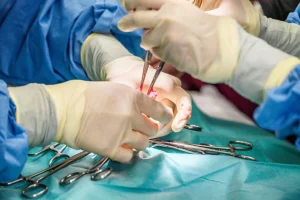Tissue forceps are instruments that grasp and manipulate soft tissues during surgical procedures. While traditional tissue forceps come equipped with teeth, there are situations where a toothless version is preferred. In this blog post, we’ll explore the advantages of using tissue forceps without teeth and the various surgical procedures where they are most helpful.
Understanding Tissue Forceps Without Teeth
As their name suggests, tissue forceps without teeth possess a distinct feature that sets them apart from other forceps commonly employed in medical procedures. In contrast to forceps with serrated edges, toothless tissue forceps are painstakingly made without these serrations. This absence of teeth significantly diminishes the risk of inadvertently harming delicate tissues during various medical procedures, rendering them an essential and unparalleled tool for surgeons and medical practitioners.
Uses in Surgical Procedures
The applications of tissue forceps without teeth span a vast spectrum of surgical procedures, showcasing their indispensable versatility. These forceps are invaluable in general surgical scenarios and within highly specialized fields such as plastic surgery and neurosurgery. Their utilization in delicate tissue handling is guided by the precision and meticulous control they offer, ensuring optimal outcomes.
Variety of Designs and Types
Tissue forceps without teeth exhibit a diverse range of designs, each tailored to cater to specific surgical requisites. The spectrum of designs includes delicate tips tailored to intricate procedures that demand exceptional finesse. Simultaneously, other variants boast broader tips strategically designed for more robust and substantial tissue manipulation. This versatility ensures that medical professionals can select the most appropriate forceps variant for their particular procedure.
Maintaining and Handling Tissue Forceps
The significance of proper maintenance and diligent handling of toothless tissue forceps cannot be overstated. Effective maintenance routines, encompassing regular cleaning and appropriate storage practices, contribute directly to these instruments’ longevity and optimal performance—these forceps’ delicate craftsmanship and intricate mechanism demand careful handling to preserve their precision and functionality.
Tissue Forceps vs. Other Instruments
When juxtaposed against Endodontic Instruments, toothless tissue forceps establish a distinctive precision and tissue preservation advantage. The absence of serrated edges mitigates the potential for unintended tissue damage, enabling medical practitioners to navigate delicate procedures with enhanced accuracy and reduced risk.
Innovations in Tissue Forceps Design
The domain of medical instrument design has witnessed significant advancements, consequently influencing innovations in tissue forceps. These progressive modifications are driven by the desire to optimize ergonomics, alleviate fatigue experienced during prolonged procedures, and ultimately enhance the usability of these instruments. The synergy of design and function contributes to a more efficient and comfortable medical practice environment.
Ensuring Proper Sterilization
In any medical setting, ensuring proper sterilization procedures is paramount. Tissue forceps without teeth are no exception to this requirement. Adequate sterilization protocols must be diligently followed to eliminate potential infections and uphold patient safety during medical interventions.
Advantages of Tissue Forceps Without Teeth:
- Reduced Tissue Damage:
Toothed forceps can sometimes cause unintended damage to delicate tissues, especially when manipulating fragile structures such as blood vessels or nerves. On the other hand, toothless forceps provide a smoother, gentler grip, minimizing the risk of tissue trauma and promoting better healing outcomes. - Improved Grip:
The absence of teeth allows for a more consistent, secure grip on tissues, which is particularly important when working with slippery or irregular surfaces. This enhanced grip also reduces the likelihood of tissue tearing or fragmentation during manipulation. - Better Accessibility:
In some surgical procedures, teeth on forceps can hinder access to specific body areas. For instance, toothless forceps can be easily inserted and maneuvered when operating on small or tight spaces without causing additional trauma or complications. - Enhanced Visualization:
The lack of teeth on tissue forceps provides an unobstructed view of the operative site, allowing surgeons to see the area they are working on clearly. This improved visualization enables more precise dissection and suturing techniques.

- Versatility:
Tissue forceps without teeth can be used in various surgical disciplines, including general surgery, orthopedic surgery, neurosurgery, ophthalmic surgery, and plastic surgery. They are instrumental in laparoscopic and endoscopic procedures, where minimal invasiveness is crucial. - Cost-Effective:
Compared to traditional toothed forceps, toothless forceps are generally less expensive, making them a cost-effective option for hospitals and clinics. These savings can be passed down to patients, contributing to more affordable healthcare overall.
Conclusion:
In conclusion, tissue forceps without teeth offer several advantages over traditional toothed forceps, including reduced tissue damage, improved grip, better accessibility, enhanced visualization, versatility, and cost-effectiveness. By understanding the benefits of toothless tissue forceps, surgeons can make informed decisions about which instrument best suits their needs and enhances patient care. At RDM Dental, we pride ourselves on providing high-quality surgical instruments, including tissue forceps without teeth, to support your work in the operating room.
Frequently Asked Questions
- What are toothless tissue forceps?
Toothless tissue forceps are surgical instruments that grasp and manipulate soft tissues during surgical procedures. They do not have any teeth or serrations on their jaws, distinguishing them from traditional tissue forceps. - Why are toothless tissue forceps used?
Toothless tissue forceps reduce the risk of unintended tissue damage, improve grip on slippery or irregular surfaces, provide better accessibility to small or tight spaces, and enhance visualization of the operative site. - How do toothless tissue forceps compare to traditional tissue forceps?
Toothless tissue forceps are designed to provide a smoother, gentler grip on tissues compared to traditional tissue forceps, which can sometimes cause damage to delicate tissues. Toothless forceps offer improved accessibility and visualization, while traditional forceps may have limitations. - Are toothless tissue forceps more expensive than traditional forceps?
No, toothless tissue forceps are generally less expensive than traditional forceps, making them a cost-effective option for hospitals and clinics. - Do toothless tissue forceps require special maintenance or cleaning?
No, toothless tissue forceps do not require special maintenance or cleaning. They should be sterilized and maintained according to standard protocols for surgical instruments.





